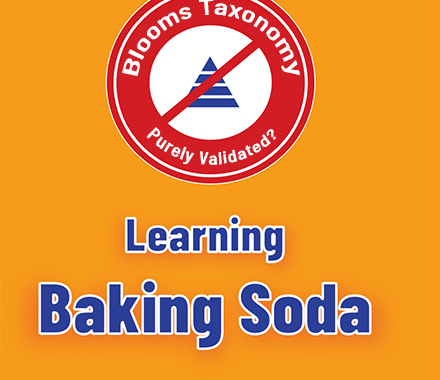Baking soda has a rich history as a multipurpose kitchen cleaner, leavening agent and even wound healing properties. Thus far, no one has claimed it to accelerate learning or help you create good learning objectives. Unfortunately, Bloom’s Taxonomy has been treated by many in L&D as the baking soda of learning design. Benjamin Bloom’s Taxonomy of Educational Objectives: The Classification of Educational Goals was published in 1956 with the sole purpose of standardize the way academic professors ensured learning objectives are aligned with examination items. Primarily, the taxonomy was fulfilling a much needed need at the time which was to help colleges adopt mass examination strategies due to the influx of US military veterans attending college due to the G.I. Bill. In 2001, Dr. Lorin Anderson and Dr. David Krathwohl teamed up and revised Bloom’s Taxonomy publishing the book A Taxonomy for Learning, Teaching and Assessing (BTW, purchases through this link, would buy me coffee; ) and this time, the focus was not solely on examinations but on curriculum and instructional design. Earlier this year, I interviewed Dr. Anderson on my vlog Learning Expert Talks regarding the true essence of the taxonomy and some of the misconceptions that seem to have turned it into the baking soda of learning design.
Bloom’s Taxonomy is NOT for the Creation of Learning Objectives
Whaaat? That’s right, a taxonomy is a classification system and analytical tool. It’s main purpose is to validate the alignment of learning objectives with instructional activities and assessments. As Dr. Anderson said in the interview, you should use the taxonomy once you have objectives. The objectives should reflect what is considered to be important. For instructional designers, the objectives should be based on business/learning needs and align to the assessment strategies. Thus, the taxonomy is not a learning objective cookbook of sorts.
The Taxonomy is NOT a Lock-step Hierarchy
On the taxonomy revision, the authors did a meta-analysis and determined that the original taxonomy supported a cumulative hierarchy where knowledge was at the foundation of all learning levels. However, that does no longer stand true in the revision. How come? Well, think about how children learn through play with legos. They may just see blocks that can interconnect and lead to creation. There’s no need to explain what is a lego or how it works. Another example applicable for adult learners is the acquisition of skills through application i.e. learning how to cook a new dish. That is one can use tools directly with guidance and learn through the experience without having to define, describe or recall items in a classroom/test. The main point is, a learning design can start at application or higher without a dependency on lower order items.
The Taxonomy is NOT an Interpretation Tool
In one of my past posts on LinkedIn, I had an extensive discussion about how one lone designer decided that Bloom’s Taxonomy was a guide for learning design that he could interpret for best use. Hhhhmm… NO! I mean do whatever floats your boat BUT why even bother then? Keep in mind that it took SIX years for Benjamin Bloom to bring about the original taxonomy. That’s six years of research by highly regarded PhD researchers and educational psychologists. The revision took even longer and included curriculum designers, and a cadre of educational scientists of similar caliber. So, we can place the same value for designers to think they can use this tool however they want, it’s professionally irresponsible.
How to use Bloom’s Taxonomy Then?
Well, first, use only the revision and avoid the original framework of the taxonomy. Know that what is known as Bloom’s Taxonomy is only addressing cognitive processes and not learning as a whole. For example; David Krathwohl developed the Learning Taxonomy for the Affective Domain and there are several other taxonomies concurrent with Bloom’s. Conduct a good training needs analysis that inspects the people (target audience), the environment (tools, spaces and resources), the job tasks (avoid subject matter, focus on observable actions) and organizational intent (company expectations of good performance) before you come up with learning objectives. Consider using Robert Mager’s seminal work Preparing Instructional Objectives which was a response to the noticeable concerns researchers in the 1960s had with Bloom’s Taxonomy.

